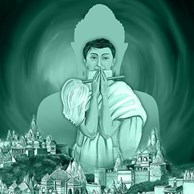One who is incapable of attaining moksha.
Abandonment of all incontience.
Perception by means of the senses other than visual.
A Sadhu who learned, mastered and taught religious scriptures, follows them, and is now the head of a Sangh. Head of a mendicant group, spiritual leader and monk-scholar.
The lower world. The home of infernal beings.
Scripture. Canonical literature.
The four types of karmas whose powers are much milder than those of the four-ghati karmas. These powers end at the end of a life.
Non-violence, non-harming. The supreme mahavrat or anuvrat that all Jains must adhere to. Jain religion is remarkable in that it upholds nonviolence as the supreme religion (Ahimsa Paramo Dharmah) and has insisted upon its observance in thought, word, and deed at the individual as well as social levels.
'Non-violence as the supreme religion.'
The highest state of a Digambara layman, wherein he retains only one piece of clothing.
Prohibition of animal sacrifice.
'Non-singular conclusivity' or multiplicity of viewpoints. The concept that humans, with obstructed knowledge, will only be able to see limited parts of any whole (situation or truth).
A Ghati karma that obstructs the strength of a soul.
A vow that is not as strict as a Mahavrat. Anuvrats are for people living family lives. The five vratas are: Ahimsa (non-violence), truth, non-stealing, non-possessiveness and chastity or self-control.
